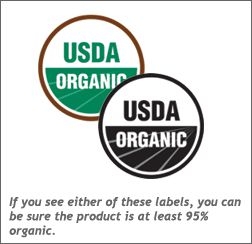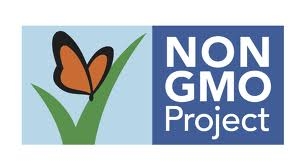Without GMO labeling requirements in the US it can be very difficult to know if you are eating GMOs. Luckily, there are some tricks if you want to avoid GMOs in your diet and support a more sustainable food supply.
Here's how!
1. Choose Organic
Buying 100% Organic, Certified Organic, and USDA Organic-labeled products is usually the easiest way to avoid genetically modified ingredients. Plus organic farming does not allow for non-organic pesticides to be used on crops so its better for our eco-systems and the farmers growing our food.
The U.S. and Canadian governments do not allow companies to label products "100% Organic" or Certified Organic if they contain GMOs.
2. Choose Non-GMO Verified Products
The Non-GMO Project seal indicates that a product has gone through the Non-GMO Project's verification process to ensure that any potential genetically modified ingredients are tested and non-GMO. (This includes ingredients that are currently being genetically modified and commercially available such as corn, soy and sugar beets.
3. Avoid potential GMO Ingredients altogether
There are currently 9 crops in the US that have been approved to be genetically modified: Alfalfa, Canola, Corn , Cotton, Papaya, Soy, Sugar Beets, Zucchini and Yellow Summer Squash. By avoiding these foods and ingredients altogether you can avoid GMOs. However it can be very tricky since over 85% of processed foods in the grocery store contain one or more of these ingredients, often disguised in other names such as corn syrup, maltodextrin, or lecithin.
Understanding the Details:
To recognize Organic and Non-GMO foods more easily, it's helpful to review the various organic and non-GMO labels and the current labeling requirements in the U.S. and Canada.

1. 100% Organic: Must contain 100% organically produced ingredients (excluding water and salt). This is the only label that certifies a completely organic product AND is also completely non-GMO.
2. Certified Organic / USDA Organic / Organic: At least 95% of content is organic by weight (excluding water and salt). The <5% remaining ingredients must consist of substances approved on the USDA’s NOSB National List. GMOs are NOT on this list, so these products are also non-GMO.
3. Made with Organic: Up to 70% of the ingredients are organic. These products can NOT carry a “USDA organic” label and may possibly contain GMO ingredients.

4. Non-GMO Verified: The verification seal indicates that the product bearing the seal has gone through the Non-GMO Project's verification process. Any GMO ingredient being grown commercially must be tested prior to use in a verified product. The Non-GMO Project has an Action Threshold of 0.9% and is in alignment with laws in the EU, where any product containing more than 0.9% GMO must be labeled. This DOES NOT mean that the crop ingredients have been grown without harmful pesticides, insecticides or chemical fertilizers it simply means that the ingredients are non-GMO.
5. GMO Ingredients: If a product contains any potential GMO ingredients (or derivatives of these ingredients) that are not organic or Non-GMO Project verified, its likely these ingredients could be genetically modified. GMO Ingredients to look out for in teh US include corn, soy, canola, cotton, sugar beets, zucchini, yellow squash, papaya and alfalfa.


